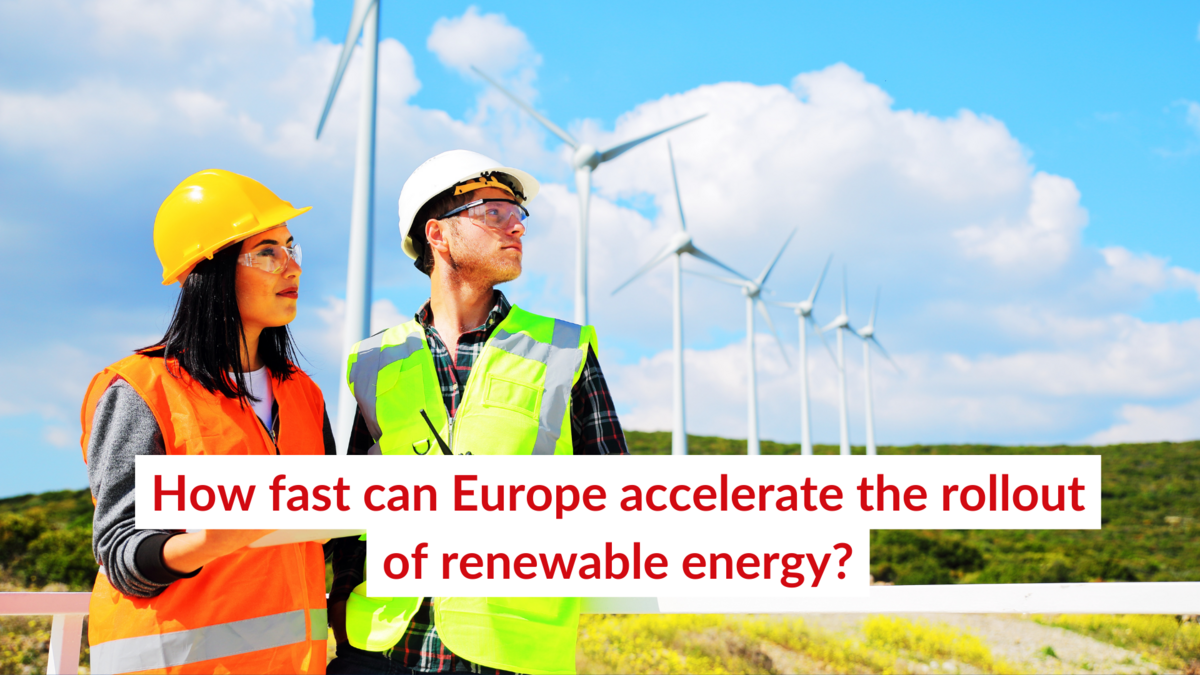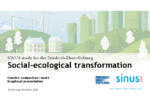Energize it, industrialize it and make it work
Foresighted structural policy is needed to ensure that Europe can assert itself in tomorrow’s tough international competition for key industries, safeguarding prosperity and providing decent jobs. The market alone will not suffice. A protective, guiding and future-oriented state is the essence of social democracy.
We shall serve as a platform for strategic exchange between industrial and energy policy and learning from the experiences of others.
On Energy, Industrial & Structural Policy
How fast can Europe accelerate the rollout of renewable energy?

What is in the proposal?
The proposed Emergency Regulation has a specific objective to address the bottlenecks in permitting procedures that hamper the accelerated deployment of renewable energy projects. Usually, the standard EU legislative process takes time. For example, it will take months and even years before the simplification measures for permitting listed initially in the REPowerEU are applied at the national level. Therefore, the goal of this Emergency Regulation is to speed up the permitting process and help unlock projects currently stuck in the administrative pipeline. In France for instance, 10 GW of renewable projects are currently held back because of this reason.
The proposed measures target specific technologies and types of projects which have the highest potential for quick deployment and the least impact on the environment:
Heat pumps: the proposal accelerates permit-granting procedures by introducing a three-month maximum deadline and a simplified procedure for grid connection of smaller heat pumps.
Solar energy: PV deployed on artificial structures – buildings, car parks, transport infrastructure, sheds – and co-located storage systems and grid connections will have a maximum deadline of one month for permitting. The proposed Regulation also exempts these installations from the need to carry out certain environmental assessments.
Repowering renewable power plants: theproposal streamlines the permit-granting process applicable to the repowering of renewable energy projects by including all the relevant environmental assessments in the new maximum deadline of six months. It also specifies that the environmental assessments should be limited to assessing the potential impacts resulting from the change or extension compared to the original project. Furthermore, it introduces a simplified procedure for grid connections in cases where the repowering doesn't exceed a 15% increase in total capacity compared to the original project.
Other novelties proposed by the Commission in the Regulation include the introduction of the following concepts:
“overriding public interest” – which means that renewable energy projects would be presumed to be of overriding public interest to ensure a balance between the expansion of renewables and other societal interests such as the protection of biodiversity. This would also provide legal clarity and could help deal with the legal challenges that so often delay the construction of new renewables projects.
“administrative positive silence” -according to the legislative text, for the installation of solar energy equipment of renewables self-consumers with a capacity of 50 kW or less, the lack of reply by the relevant authorities or entities within one month following the application shall result in the permit being considered as granted.
Why are these measures temporary?
According to the Commission`s proposal, the Emergency Regulation will apply only for one year, covering the time needed for the adoption and entry into force of the revision of the Renewable Energy Directive (EU legislation on the promotion of the use of energy from renewable sources), currently being debated in the European Parliament and the Council. This means that the proposed temporary measures under the Emergency Regulation can be seen as a “bridge” legislation until the Renewable Energy Directive (RED) reforms are in force.
Stakeholders are partially satisfied
Experts and several associations have welcomed the proposal in principle, yet some remaining concerns and challenges have been underlined as well. For example, the European Environmental Bureau (EEB), the largest network of environmental citizens’ organisations in Europe, highlighted in their reaction that this proposal does not provide ‘emergency’ quick solutions – shorter deadlines in themselves do not address the actual challenges of improving administrative, digital and technical capacity and finances. On the contrary, they will lead to non-compliance with legal safeguards, poor permits, and lengthy legal problems and social backlash later down the line. According to them, it is also unclear in the proposal how the continuous obligations of the Directives will apply to projects once the one-year bridge is lifted again.
Environmental rules become less important?
As a general rule, project developers are required to make every effort not to unduly burden the natural environment when developing new projects. However, with the status of “overriding public interest,” renewable energy projects will now take precedence when environmental laws would normally get in the way of a project. This means, for example, that if a developer makes every effort to avoid negative impacts on plants or animals and environmental damage does ensue, it will be accepted as an unfortunate side effect. Another easing of environmental rules is that a comprehensive environmental impact assessment is not required anymore for solar parks constructed in the built environment (for example, on top of buildings, above parking lots or alongside roads). The same applies to smaller solar energy projects (up to 50 kW) in other locations.
District heating and industrial-size heat pumps are left out
District heating, where heat is produced centrally and distributed to households through pipes, is recognised as one of the most efficient ways of decarbonising heat at a low cost. According to Euroheat and Power, the association for district energy, the Emergency Regulation fails to explicitly mention district heating and cooling networks (DHC) as key infrastructure for deploying renewable heat sources. The regulation appears too focused on small residential heat pumps, while large heat pumps (2MW up to 55 MW) can bring major benefits too, as highlighted by the Euroheat and Power. District heating especially is suffering from high fossil fuel prices. With gas and coal prices reaching record levels, the industry has been forced to eye heat pumps as a source of heat earlier than expected, which could be aided by speedier permits. Similarly, the industry needs heat, much of it at low temperatures that can be easily produced without using fossil fuels. Jan Rosenow, Director for Europe at the Regulatory Assistance Project, noted that there should be a similar acceleration regime “for large industrial heat pumps too”.
Next steps
The proposed Regulation is expected to be officially adopted at the Energy Council meeting of EU ministers on the 24th of November 2022. Until then, national governments can still amend the proposed text of the Regulation. For example, the Czech Presidency of the Council submitted a first compromise proposal ahead of the Energy Council meeting, where it proposed to prolong the period of application of this Emergency Regulation to 18 months, instead of one year as proposed by the Commission, in order to maximise the impact of the proposed provisions. Member States are expected now to reach a political agreement during the Energy Council meeting. In this sense, the Commission expects a positive vote on its proposal.
Given the context, it is also important to note that national governments will have no other choice than to implement these provisions, as a "regulation" is a binding legislative act that must be applied in its entirety across the EU.Moreover,when the European Commission is putting forward an Emergency Regulation, it means that only EU national governments have to agree to it, without the involvement of the European Parliament. When adopted by the Council, where all EU governments are seated, it will enter into force as a matter of urgency and will be directly applicable in all Member States by the end of the year.
Conclusion
European leaders fear that gas reserves will not manage to be filled over the coming year. The gas reserves have been stockpiled for this winter. However, realistically no gas is expected to be supplied from Russia to Europe next year. Since it is still uncertain whether enough LNG quantity will be available to make up the shortfall, the European Commission is seeking to drastically reduce the demand for natural gas. In practical terms, this requires that renewables become far more abundantly available very soon hence why the EU has been so prompt in proposing this Emergency Regulation.
This proposal represents a relief for the renewable energy industry, as permitting and licensing have always been one of the key bottlenecks for speeding up the development of such projects. Will this finally provide the speed that renewable projects need? The stakes are pretty high and there are some positive examples already in this area. Recently, the German government inaugurated its first floating terminal on 15 November, built in record time. The completion in 194 days represented an unprecedented pace of construction in Germany, made possible also by permitting exceptions. Ultimately, the success of the proposed measures will be analysed based on the number of renewable energy projects that will be commissioned during this period of application of the Emergency Regulation.
Reghina Dimitrisina is Policy Advisor at FES Just Climate. She possesses expertise in climate and energy policies and European affairs. Prior to joining the FES Team, she worked as Policy Officer for the European Geothermal Energy Council (EGEC) and advised MEPs from the S&D and EPP political groups in the European Parliament. She studied international relations and political communications.
All News & Events
How fast can Europe accelerate the rollout of renewable energy?

What is in the proposal?
The proposed Emergency Regulation has a specific objective to address the bottlenecks in permitting procedures that hamper the accelerated deployment of renewable energy projects. Usually, the standard EU legislative process takes time. For example, it will take months and even years before the simplification measures for permitting listed initially in the REPowerEU are applied at the national level. Therefore, the goal of this Emergency Regulation is to speed up the permitting process and help unlock projects currently stuck in the administrative pipeline. In France for instance, 10 GW of renewable projects are currently held back because of this reason.
The proposed measures target specific technologies and types of projects which have the highest potential for quick deployment and the least impact on the environment:
Heat pumps: the proposal accelerates permit-granting procedures by introducing a three-month maximum deadline and a simplified procedure for grid connection of smaller heat pumps.
Solar energy: PV deployed on artificial structures – buildings, car parks, transport infrastructure, sheds – and co-located storage systems and grid connections will have a maximum deadline of one month for permitting. The proposed Regulation also exempts these installations from the need to carry out certain environmental assessments.
Repowering renewable power plants: theproposal streamlines the permit-granting process applicable to the repowering of renewable energy projects by including all the relevant environmental assessments in the new maximum deadline of six months. It also specifies that the environmental assessments should be limited to assessing the potential impacts resulting from the change or extension compared to the original project. Furthermore, it introduces a simplified procedure for grid connections in cases where the repowering doesn't exceed a 15% increase in total capacity compared to the original project.
Other novelties proposed by the Commission in the Regulation include the introduction of the following concepts:
“overriding public interest” – which means that renewable energy projects would be presumed to be of overriding public interest to ensure a balance between the expansion of renewables and other societal interests such as the protection of biodiversity. This would also provide legal clarity and could help deal with the legal challenges that so often delay the construction of new renewables projects.
“administrative positive silence” -according to the legislative text, for the installation of solar energy equipment of renewables self-consumers with a capacity of 50 kW or less, the lack of reply by the relevant authorities or entities within one month following the application shall result in the permit being considered as granted.
Why are these measures temporary?
According to the Commission`s proposal, the Emergency Regulation will apply only for one year, covering the time needed for the adoption and entry into force of the revision of the Renewable Energy Directive (EU legislation on the promotion of the use of energy from renewable sources), currently being debated in the European Parliament and the Council. This means that the proposed temporary measures under the Emergency Regulation can be seen as a “bridge” legislation until the Renewable Energy Directive (RED) reforms are in force.
Stakeholders are partially satisfied
Experts and several associations have welcomed the proposal in principle, yet some remaining concerns and challenges have been underlined as well. For example, the European Environmental Bureau (EEB), the largest network of environmental citizens’ organisations in Europe, highlighted in their reaction that this proposal does not provide ‘emergency’ quick solutions – shorter deadlines in themselves do not address the actual challenges of improving administrative, digital and technical capacity and finances. On the contrary, they will lead to non-compliance with legal safeguards, poor permits, and lengthy legal problems and social backlash later down the line. According to them, it is also unclear in the proposal how the continuous obligations of the Directives will apply to projects once the one-year bridge is lifted again.
Environmental rules become less important?
As a general rule, project developers are required to make every effort not to unduly burden the natural environment when developing new projects. However, with the status of “overriding public interest,” renewable energy projects will now take precedence when environmental laws would normally get in the way of a project. This means, for example, that if a developer makes every effort to avoid negative impacts on plants or animals and environmental damage does ensue, it will be accepted as an unfortunate side effect. Another easing of environmental rules is that a comprehensive environmental impact assessment is not required anymore for solar parks constructed in the built environment (for example, on top of buildings, above parking lots or alongside roads). The same applies to smaller solar energy projects (up to 50 kW) in other locations.
District heating and industrial-size heat pumps are left out
District heating, where heat is produced centrally and distributed to households through pipes, is recognised as one of the most efficient ways of decarbonising heat at a low cost. According to Euroheat and Power, the association for district energy, the Emergency Regulation fails to explicitly mention district heating and cooling networks (DHC) as key infrastructure for deploying renewable heat sources. The regulation appears too focused on small residential heat pumps, while large heat pumps (2MW up to 55 MW) can bring major benefits too, as highlighted by the Euroheat and Power. District heating especially is suffering from high fossil fuel prices. With gas and coal prices reaching record levels, the industry has been forced to eye heat pumps as a source of heat earlier than expected, which could be aided by speedier permits. Similarly, the industry needs heat, much of it at low temperatures that can be easily produced without using fossil fuels. Jan Rosenow, Director for Europe at the Regulatory Assistance Project, noted that there should be a similar acceleration regime “for large industrial heat pumps too”.
Next steps
The proposed Regulation is expected to be officially adopted at the Energy Council meeting of EU ministers on the 24th of November 2022. Until then, national governments can still amend the proposed text of the Regulation. For example, the Czech Presidency of the Council submitted a first compromise proposal ahead of the Energy Council meeting, where it proposed to prolong the period of application of this Emergency Regulation to 18 months, instead of one year as proposed by the Commission, in order to maximise the impact of the proposed provisions. Member States are expected now to reach a political agreement during the Energy Council meeting. In this sense, the Commission expects a positive vote on its proposal.
Given the context, it is also important to note that national governments will have no other choice than to implement these provisions, as a "regulation" is a binding legislative act that must be applied in its entirety across the EU.Moreover,when the European Commission is putting forward an Emergency Regulation, it means that only EU national governments have to agree to it, without the involvement of the European Parliament. When adopted by the Council, where all EU governments are seated, it will enter into force as a matter of urgency and will be directly applicable in all Member States by the end of the year.
Conclusion
European leaders fear that gas reserves will not manage to be filled over the coming year. The gas reserves have been stockpiled for this winter. However, realistically no gas is expected to be supplied from Russia to Europe next year. Since it is still uncertain whether enough LNG quantity will be available to make up the shortfall, the European Commission is seeking to drastically reduce the demand for natural gas. In practical terms, this requires that renewables become far more abundantly available very soon hence why the EU has been so prompt in proposing this Emergency Regulation.
This proposal represents a relief for the renewable energy industry, as permitting and licensing have always been one of the key bottlenecks for speeding up the development of such projects. Will this finally provide the speed that renewable projects need? The stakes are pretty high and there are some positive examples already in this area. Recently, the German government inaugurated its first floating terminal on 15 November, built in record time. The completion in 194 days represented an unprecedented pace of construction in Germany, made possible also by permitting exceptions. Ultimately, the success of the proposed measures will be analysed based on the number of renewable energy projects that will be commissioned during this period of application of the Emergency Regulation.
Reghina Dimitrisina is Policy Advisor at FES Just Climate. She possesses expertise in climate and energy policies and European affairs. Prior to joining the FES Team, she worked as Policy Officer for the European Geothermal Energy Council (EGEC) and advised MEPs from the S&D and EPP political groups in the European Parliament. She studied international relations and political communications.
Contact
Friedrich-Ebert-Stiftung
Climate and Social Justice
Cours Saint Michel 30e
1040 Brussels, Belgium







